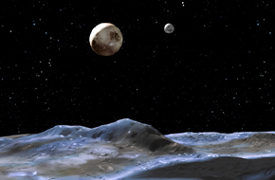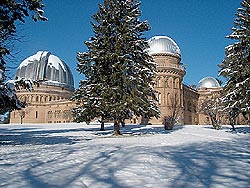
Pluto's newest moons, Nix and Hydra, were spotted by the Hubble Space Telescope in May 2005 and named in June 2006.
Arguably the biggest astronomy story of the year was the hullabaloo about Pluto, and whether it should be classified as a planet. Astronomers were outraged, children cried, and late-night comedians joked. But in the end, the solar system shrugged. Although the International Astronomical Union voted to officially remove Pluto from the ranks of full-fledged planetdom, and the Minor Planet Center gave the world an asteroid number, we can be sure that the issue isn't over yet. Regardless of its status, Pluto will remain in the gaze of astronomers. Its two new moons were named in June. And the world will have a visitor — NASA's New Horizons probe launched on January 19th and will make a flyby in 2015. Hopefully by then, astronomers will settle on what Pluto is.

Two images shot with the Mars Global Surveyor's Mars Orbiter Camera six years apart provide strong evidence of a recent flow of water.
NASA/JPL/MSSS
The Pluto uproar of August was the loudest part of a yet another year of astronomical triumph and disappointment. Nowhere was this more apparent but on the Red Planet, where the multimission exploration continues. Excitement peaked several weeks ago when researchers found surface changes that may indicate events of contemporary flowing water. Curiously, the announcement came a month after the spacecraft that led to the discovery, Mars Global Surveyor, fell silent. Nevertheless, the planetary invasion continues, with the arrival of Mars Reconnaissance Orbiter last March. It joined Mars Express, whose camera has dazzled earthlings with high-resolution orbital images of the robotic landers of past and present.
Elsewhere in the solar system, Jupiter developed a new junior Red Spot, Periodic Comet Schwassmann-Wachmann 3 crumbled in front of our telescopes, and the Cassini spacecraft continued to reveal discoveries, from detail on the surface of Titan to curiosities in Saturn's rings.
At the start of the year, the Stardust probe returned back to Earth after spending months collecting interplanetary debris. Scientists pore over the
minute bits it captured for clues to the solar system's formation.

The century-old Yerkes Observatory went up for sale this past year.
Beyond our local realm, astronomers continue to find new planets around other stars. Some are puffy, some lie 20,000 light-years away, and one's parent star lies in obvious view.
Meanwhile, on the ground, Hawaiian observatories rocked and rolled in a large earthquake but suffered no major damage. Tremors of a budgetary nature propagated as research projects and facilities faced cancellation or closure. The Hubble Space Telescope will be rescued from the brink. And SOFIA was saved from the budget ax and will soon get off the ground. While Wisconsin's venerable Yerkes Observatory may have changed owners, it will remain an institution of research. But the future remains cloudy for other facilities, including Arecibo Observatory's giant radio telescope, whose ear may become deaf because of cuts by the National Science Foundation.
This sampling of astronomical events during the past 12 months represent just a fraction of the stories we've covered on SkyandTelescope.com and in Sky & Telescope. The pace of celestial discoveries will surely continue, and we'll be bringing them to you through 2007 and beyond.
Happy New Year!
 0
0
Comments
You must be logged in to post a comment.